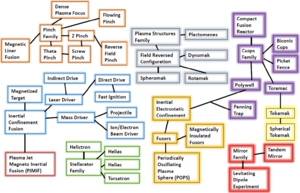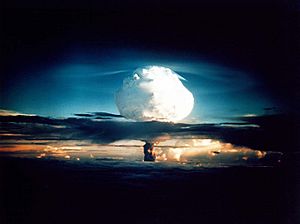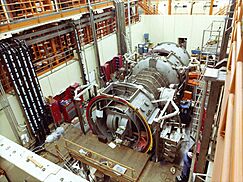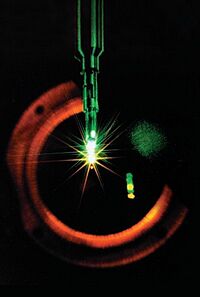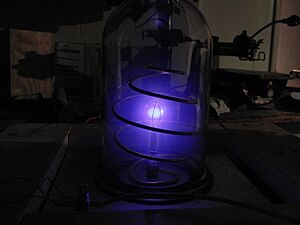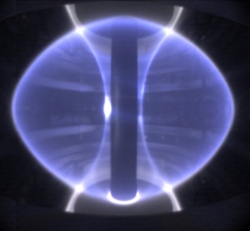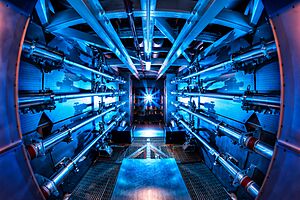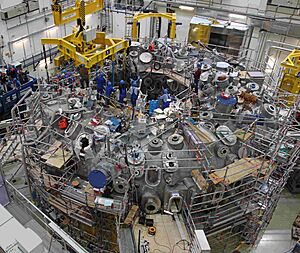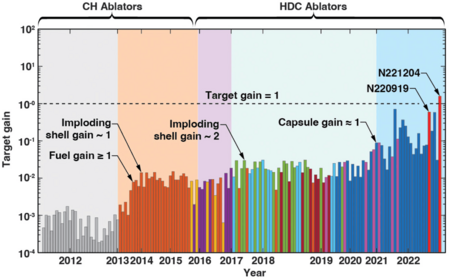History of nuclear fusion facts for kids
The history of nuclear fusion is about how scientists learned to make tiny atoms join together, just like they do inside stars. This process, called nuclear fusion, releases a lot of energy. For a long time, scientists have been trying to use this amazing power for things like making electricity and even for space travel.
Contents
- Early Discoveries
- The 1950s: Big Steps and Challenges
- The 1960s: Lasers and Tokamaks Take Off
- The 1970s: Bigger Lasers and Tokamaks
- The 1980s: Mirrors, Lasers, and New Tokamak Ideas
- The 1990s: Records and New Concepts
- The 2000s: Amateurs and Advanced Tokamaks
- The 2010s: Accelerating Research
- The 2020s: Breaking Records
Early Discoveries
In 1920, a British scientist named Francis William Aston found something interesting. He noticed that four hydrogen atoms weigh a little more than one helium atom. This meant that if you could combine hydrogen atoms to make helium, the extra mass would turn into energy! This was the first clue about how stars like our Sun make so much heat and light.
Later in the 1920s, Arthur Stanley Eddington suggested that the Sun gets its power from a process called the proton–proton chain reaction. This is where hydrogen atoms fuse together. In 1929, scientists like Robert d'Escourt Atkinson and Fritz Houtermans showed that a lot of energy could be released by fusing small atoms.
Scientists also learned about something called quantum tunneling. This explains how fusion can happen even at lower temperatures than first thought.
In 1932, John Cockcroft and Ernest Walton built a machine called a particle accelerator. They used it to split lithium atoms. This was the first time humans had caused a nuclear reaction. Then, working with Ernest Rutherford, Mark Oliphant used this machine to create helium-3 and tritium atoms. This was the first time humans had actually made fusion happen!
In 1939, Hans Bethe explained more about how the Sun works. He won the Nobel Prize in Physics in 1967 for his ideas.
The first patent for a fusion reactor was filed in 1946 in the UK. It was based on a design called the Z-pinch.
The 1950s: Big Steps and Challenges
The first time humans made fusion happen on a large scale was with powerful bombs. The first true fusion bomb was called Ivy Mike, tested in 1952. These bombs used a smaller explosion to heat and squeeze the fusion fuel, which then released even more energy.
Stellarators and Pinches
In 1949, a scientist named Lyman Spitzer started thinking about how to hold super-hot gas, called plasma, in place. He invented a design called the stellarator. His work led to the creation of the Princeton Plasma Physics Laboratory.
Other scientists, like James L. Tuck, worked on different designs called "pinch" machines. But these early machines had problems. The hot plasma was very unstable and would leak out.
In 1954, Edward Teller gathered fusion scientists. He explained that many designs were unstable because the magnetic fields holding the plasma were like rubber bands that would snap back, letting the plasma escape.
ZETA and Scylla
The UK built a large pinch machine called ZETA in 1957. In 1958, scientists excitedly announced they had achieved fusion with ZETA. But it turned out the neutrons they saw were not from fusion. This was a big disappointment for the field.
However, in 1958, a machine called Scylla I at Los Alamos National Laboratory (LANL) successfully created controlled fusion. It used a "theta-pinch" to heat deuterium gas to 15 million degrees Celsius, making atoms fuse and produce neutrons.
Tokamaks: A New Hope
In the Soviet Union, scientists Igor Tamm and Andrei Sakharov came up with a new design called the tokamak in the early 1950s. This design combined ideas from pinch machines and stellarators. It used magnetic fields in a special way to hold the plasma much better. This was a huge step forward!
Other Developments
In 1955, John D. Lawson created the Lawson criterion. This is a rule that tells scientists how hot and dense plasma needs to be, and for how long, for a fusion reactor to produce more energy than it uses.
The 1960s: Lasers and Tokamaks Take Off
In 1960, John Nuckolls suggested a new idea called inertial confinement fusion (ICF). This involves using powerful lasers to quickly heat and squeeze a tiny pellet of fusion fuel. The laser itself was invented the same year, making this idea possible.
In 1962, scientists at LLNL (Lawrence Livermore National Laboratory) started thinking about using lasers for fusion. Laser fusion research began in 1965.
By the mid-1960s, fusion research was still struggling with plasma leaking out of machines. But then, in 1968, the Soviet Union announced amazing results from their T-3 tokamak. They claimed much higher temperatures than any other device. A British team visited and confirmed the results. This made many other countries switch their fusion research to tokamaks.
Another type of fusion device, the Farnsworth-Hirsch Fusor, was developed by Philo Farnsworth and Robert L. Hirsch. It used electric fields to try and fuse atoms.
The 1970s: Bigger Lasers and Tokamaks
After the success of the Soviet tokamaks, Princeton's converted stellarator also showed good results. This led to plans for even larger tokamak machines.
In 1972, John Nuckolls explained the idea of "fusion ignition." This is like a chain reaction where the heat from fusion reactions helps start even more reactions. This idea led to the building of huge laser systems like Shiva laser at LLNL, which was completed in 1977. It cost $25 million and was as big as a football field!
In 1974, a company called KMS Fusion achieved the world's first laser-induced fusion using a tiny pellet of fuel.
The Princeton Large Torus (PLT), a follow-up to earlier tokamaks, set new temperature records. It even reached temperatures needed for a commercial reactor.
The 1980s: Mirrors, Lasers, and New Tokamak Ideas
In the late 1970s and early 1980s, the US also funded research into "magnetic mirror" devices. These machines used strong magnets at the ends to try and bounce plasma back and forth. However, they had problems with plasma escaping.
Laser fusion continued to advance. In 1983, the NOVETTE laser was finished, followed by the ten-beam NOVA laser in 1984. NOVA could deliver huge amounts of laser energy. Scientists also found ways to make lasers more efficient by changing their light from infrared to ultraviolet.
In 1985, Donna Strickland and Gérard Mourou invented a method called "chirped pulse amplification." This allowed lasers to be made much more powerful.
Spherical Tokamaks
In 1984, Martin Peng suggested a new design for tokamaks called the spherical tokamak. This design made the reactor much more compact and efficient. The first experimental machine of this type, called START, was built in the UK and started operating in 1991. It achieved a record for plasma pressure compared to magnetic field pressure.
ITER is Born
The idea for the International Thermonuclear Experimental Reactor (ITER) began to form. This was a huge international project involving many countries, aiming to build a very large fusion reactor.
The 1990s: Records and New Concepts
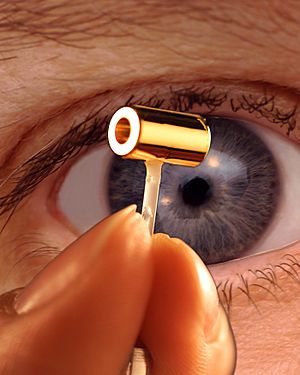
In 1991, the JET machine achieved the world's first controlled release of fusion power using a mix of deuterium and tritium fuel.
Scientists pushed for a "national ignition facility" for laser fusion. This led to the approval of the NIF project in the US in the late 1990s.
In 1993, the TFTR machine at Princeton reached 10 megawatts of fusion power using deuterium and tritium.
New ideas like "fusors" and "polywells" were explored. These devices used electric fields to try and fuse atoms. In 1995, the University of Wisconsin–Madison built a large fusor called HOMER.
In 1997, JET set a new record, producing 16.1 megawatts of fusion power and sustaining over 10 megawatts for half a second. This was a major achievement.
ITER was officially announced as a project with seven partners (six countries and the EU). ITER was designed to produce ten times more fusion power than the energy put into it. The US left the project in 1999 but later rejoined.
The 2000s: Amateurs and Advanced Tokamaks
A new idea called "fast ignition" emerged for laser fusion, promising to save a lot of power.
In 2001, the United States, China, and South Korea joined the ITER project.
In 2005, a team at UCLA found a way to produce fusion using a small machine on a lab bench, but it didn't produce net power.
The next year, China's EAST reactor was completed. This was the first tokamak to use special superconducting magnets for both its magnetic fields.
In 2009, the NIF in the US became operational.
Private companies also started to get involved in fusion research, exploring different approaches like field-reversed configuration and Magnetized target fusion.
The 2010s: Accelerating Research
Both private companies and government-funded projects sped up their fusion research in the 2010s.
Private Companies Step Up
Companies like General Fusion and TAE Technologies made progress with their plasma machines. In 2014, Phoenix Nuclear Labs sold a device that could produce a lot of neutrons from fusion reactions.
In 2014, Lockheed Martin announced plans for a compact fusion reactor, though they later realized it would need to be much larger.
In 2018, an Italian energy company, Eni, invested $50 million in Commonwealth Fusion Systems. This company is working with MIT to develop a new type of tokamak using special high-temperature superconducting magnets. In 2021, they successfully tested a very powerful magnet, which was a big step forward.
Government and Academic Progress
At NIF, researchers worked on "tuning" their laser shots to get closer to ignition. In September 2013, they achieved a net energy gain from the fuel itself.
In 2014, MIT announced a new tokamak design called ARC fusion reactor, which also uses advanced superconducting magnets.
In 2015, the largest stellarator ever built, the Wendelstein 7-X, was completed in Germany. It produced its first plasma in 2016. This machine aims to show that stellarators can operate continuously with hot plasma.
China's EAST reactor set new records for holding plasma in a stable state for long periods. In 2017, it held a high-confinement plasma for over 101 seconds.
In 2019, the UK announced plans to design a fusion facility called STEP by the early 2040s.
The 2020s: Breaking Records
The 2020s have seen exciting new records in fusion research.
In December 2020, China's HL-2M reactor achieved its first plasma. In May 2021, the EAST reactor set a new world record, holding plasma at 120 million degrees Celsius for 101 seconds! In December 2021, EAST set another record, holding 70 million degree Celsius plasma for over 17 minutes.
In August 2021, the National Ignition Facility (NIF) made a huge breakthrough. It created 1.3 megajoules of energy from fusion. This was the first time the Lawson criterion was clearly surpassed in a lab, meaning the fusion reaction produced more energy than the laser energy put into the fuel.
In February 2022, the JET machine sustained 11 megawatts of power for over 5 seconds, releasing almost 60 megajoules of energy using deuterium and tritium fuel. In March 2022, Tokamak Energy reached a record plasma temperature of 100 million kelvins in a compact tokamak.
In October 2022, the KSTAR tokamak in Korea reached a record plasma duration of 45 seconds at over 100 million degrees Celsius.
Then, in December 2022, the NIF achieved "scientific breakeven." This means the fusion reaction produced more energy than the laser energy used to start it, with an energy gain of 1.5! This was a historic moment in fusion research.
In February 2024, the KSTAR tokamak set new records for holding plasma. It held a magnetically confined plasma for 102 seconds and maintained a temperature of 100 million degrees Celsius for 48 seconds.
|


